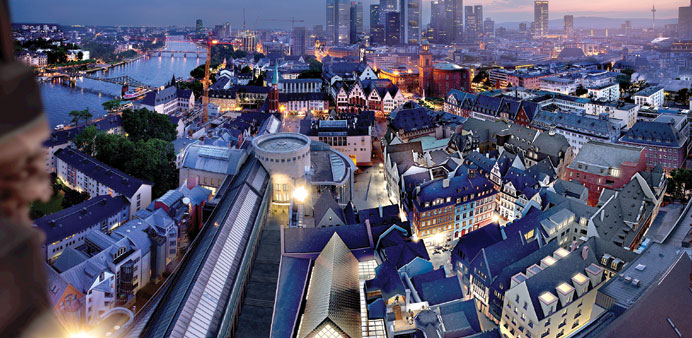VANTAGE POINT: A digital image from above of buildings to be reconstructed on the site where several alleys of pre-war Frankfurt were destroyed in World War II bombing. At left is the Main river and at back are office skyscrapers.
By Ira Schaible
The reddish facade of a new events venue already reaches upwards alongside the landmark of Frankfurt’s Catholic Cathedral, as the city seeks to turn its architectural clock back to before the devastating bombing raids of World War II.
Already complete is the ground floor of the house occupied by an aunt immortalised by the city’s most famous son — national poet Johann Wolfgang von Goethe — in his autobiography Dichtung und Wahrheit.
Several alleys of Frankfurt’s Old City are taking shape again over an area the size of a soccer pitch between the cathedral and the Roemer — a medieval building that has served as city hall for centuries and was itself badly damaged by the bombs.
Fifteen historic buildings are being reconstructed and 20 of modern design will fill the gaps, aiming to recreate the cramped conditions that prevailed before Allied bombers destroyed the city centre just a year before the end of the war.
“Everything is going to plan,” says Patrik Brummermann. By the start of next year the basic structures of the buildings will be complete.
“But we can hand them over only once they are fully finished,” says Brummermann of the DomRoemer company tasked with the project.
Most of the work is to be completed by the end of 2017, with the last details of the most noteworthy of the buildings — the house of the “Goldene Waage” (Golden Scales) — being finished at the start of 2018.
This half-timbered Renaissance house built by a rich Flemish spice trader in 1619 is to be completely replicated. It abuts the new events venue facing the cathedral square, to be used for parties and concerts, and will remain in the possession of the city authorities.
The ground floor will be given over to restaurants to help bring the square in front of the cathedral to life, while the upper floors will be used by the Historical Museum, according to Brummermann.
Frankfurt was rebuilt in modern style after the spring 1944 bombing, but with many of its unattractive post-war buildings reaching the end of their life cycle, interest has grown in recreating the look of the past.
First a 20,000-square-metre underground carpark was built, then concrete frames copying the pre-war buildings were erected over it, with replica roofs to follow. The interiors will be modern, but the facades will be hand-crafted reproductions of the past.
Frankfurt is one of the last German cities to attempt to replicate whole streets of what was lost in the war. Dresden’s centre has, for example, been almost completely rebuilt, despite criticism that the replicas lack the patina and crookedness of age.
Critics say Frankfurt’s old-new alleyways will be just too squeaky clean and look like a theme park, not an historic place.
Deputy mayor Olaf Cunitz, an historian, defends the creation of a “lively quarter” in the centre of Germany’s financial capital and rejects allegations that a kind of Disneyland is being created.
“We are building neither a museum nor an amusement park,” he says.
Possessing Germany’s main air hub, wealthy Frankfurt is a major shopping destination for tourists visiting from other continents, and the city hopes they will be enchanted.
The Frankfurt project is to cost around 170 million euros (190 million dollars), of which the city will stump up 100 million.
How constricted space was before the area was laid waste can be seen from the proximity of the events venue, or Stadthaus, to the cathedral. It blocks a view of the cathedral — a fact that many have complained about.
But this is historically accurate and so what was demanded, Brummermann says.
For example the distance from the Esslinger — the house occupied by Goethe’s relatives — to its neighbour at the address Markt 20 is just 3 metres. “But that is the most restricted spot,” Brummermann says.
It borders the Huehnermarkt — the Chicken Market — where passers-by will be able to have a coffee in front of a fountain.
The home of Goethe’s aunt is one of the few with a half-timbered ground floor and will be painted white. The city has decided to retain original colours where possible.
The Esslinger, a Gothic half-timbered structure, was built in the mid-14th century, with Goethe’s uncle later having it rebuilt in the style of the Late Baroque. The building will have a commercial use, although it is not yet clear precisely what this will be.
Brummermann says that a decision on who will occupy the 20 small shops will be taken only next year. But it has been decided that no high-street chains will be allowed.
The 20 new buildings with a total of 54 flats have already been snapped up, with the apartments measuring from a tiny 35 to a generous 190 square metres and costing between 5,000 and 7,200 euros per square metre.
By contrast, the space in the Esslinger house, the neighbouring Old Esslinger and the Golden Lamb is not yet on the market, with one possibility that a museum could take some of the space.
The “Coronation Route” taken by Holy Roman Emperors from the Roemer to be crowned in the cathedral can already clearly be seen. “The pergola will be the last item that we build,” Brummermann says. — DPA

